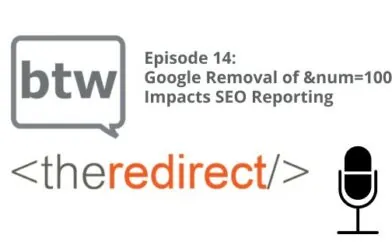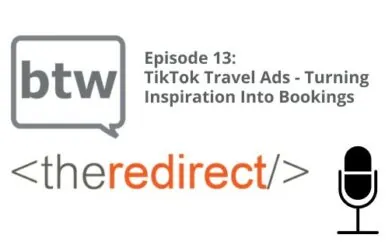Listen Now
Episode 68 of The Redirect Podcast: SearchLove San Diego 2019 took place the first week of March (2019) and delivered some great actionable takeaways. The biggest topics were surrounding Local SEO changes and Content. We share insights on how you can better understand your local SEO efforts. Plus, what is your marketing team doing to identify blind spots in digital marketing, specifically search marketing? Moving into 2019, website performance is a big issue with Google’s page speed update. Image optimization offers up big opportunities, but not all browsers are created equal. This an more on The Redirect Podcast.
SearchLove 2019 – Insights on Local SEO
Jason spent a couple of days out at SearchLove San Diego last week and wanted to share a couple of notes from there. While the notes are quite extensive, cherry picking a few items to discuss on this episode will prove to be helpful. Common themes from SearchLove were very much on local search, as well as content focused and technical site performance.
Local SEO in 2019 and Beyond
Stemming from a great talk given by Dana DiTomaso from KickPoint, understanding your local search presence is key. While it should be very straight forward for many digital marketers to understand “what” and “how” of a search, but really digging in and getting to what it is that you’re looking at. Do you understand the data and signals at a local level?
UTM tracking code use within your Google MyBusiness has been used by savvy digital markters as a way to show traffic, via campaign reporting, that’s coming in directly from the GMB listing. Google has stated they’re going to do away with this all together and not pass the variables.
July 2019 Edit – to date, this tactic still works.
For awhile now, most savvy marketers have used UTM tracking on the inbound link from your GMB listing to the site itself. Because otherwise, you hadn’t a clue (especially in search console) where that traffic was coming from. There was no way to parse it out from the rest of the pack.
The problem is – this is and has gone away. IF you’re using UTM tracking on your link from GMB this is now getting canonicalized by Google and it’s stripping the UTM off. Meaning you LOSE all traceability of that traffic. So… what are we left with?
What about people using UTM Codes ON Their site. As in other internal links because they want to see where people are going or coming from? The problem here is the same… this is not the proper way to track these actions and you can strip the data out and not see the full picture.
Instead, this is where you want to be measuring via elements in Google Tag Manager
Takeaway: Utilize the power of Google Tag Manager. Yes it can feel daunting, but that’s what you have firms like us for, right? (wink wink)
Page Speed is Costing Millions
How important is pagespeed? Consider this perspective that relates to your bottom line.
Amazon reported a 0.1 second increase that resulted in a 1% decrease in online sales– about $1.6B annually. Walmart, on the other hand, saw a 1 second DECREASE in page load time, resulting in a 2% lift in conversion rates. For them, that is about $274M per year. Not bad.
Source: https://www.stonetemple.com/page-speed-guide/
Takeaway:
As we already mentioned, page speed is a well known factor in the performance of your website related to online searches. Having recently read an article that touched on this from a different perspective, one that highlights on the monetary impacts caused by web page load speeds.

Some pretty interesting perspective provided here, and as we point out- if you’re looking to build an argument for dedicated more time to optimizing images or other aspects of your site, this just might be the way to get it across.
To further backup your argument, Google has built a pagespeed impact calculator and included it within their Test My Site report generator. After inputting a few KPIs, you’ll be able to see a rough estimation of the monetary benefits from improving your page speed.
Going back to previous statements on the dimension and resolution of images- if you own or manage an e-commerce site with lots of high resolution product images, it may be wise to go back and make sure those are optimized appropriately.
If you’re looking for a deeper analysis of your page speed, and opportunities to reduce load times- Google, again, has another tool known as PageSpeed Insights. This tool received a pretty major update back in November of 2018, when it began using data from the speed tool known as Lighthouse.
Without going down too deep in the capabilities of this tool, which would take all day, the key takeaway here is that the new PageSpeed Insights tool can offer you a plethora of recommended changes by Google- and reasons why.
— not included in podcast —
Think of having great site performance metrics such as page speed a bit like dieting and exercise. It’s something that we all agree we need to pay attention to strive to be better at, and since we aren’t all professional athletes, most of us fall within the average.
Page speed is very similar, take Apple for example. One would assume that with their incredible resources (and thirst for bigger profit margins) they would have figured this out, and be in the upper echelon of site performance. Yet, their site performance scores are not great, as seen bel0w. With that, I hope you find some encouragement from the fact that even market giants like Apple are still working on their site performance, too.
Thanks for tuning in! To catch future episodes of The Redirect Podcast, subscribe on SoundCloud, iTunes, or Stitcher.




